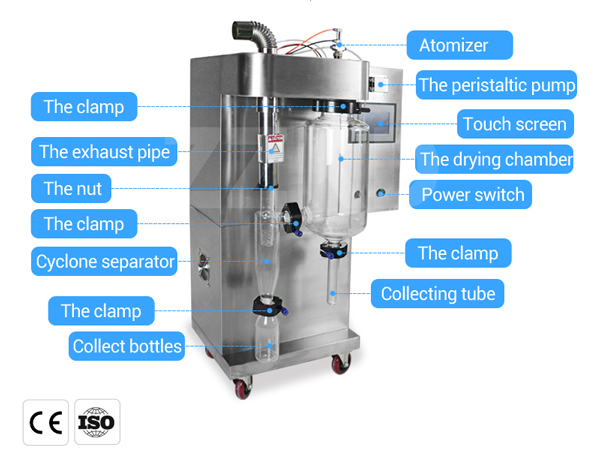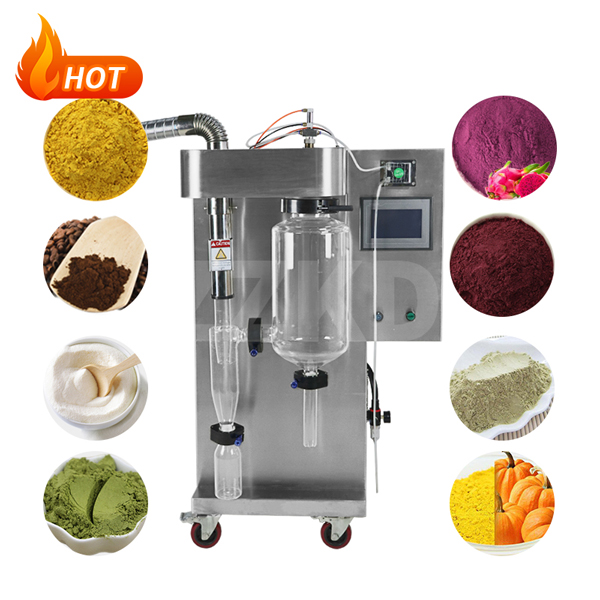Lab Scale Spray Dryer
The lab scale spray dryer produced by our company is made of 304 stainless steel and full borosilicate glass, which is convenient for visual monitoring of the process status. Full borosilicate glass for intuitive monitoring of process status.
Lab scale spray dryer operation method:
1. When the inlet temperature of the drying chamber of the spray dryer reaches the set temperature, turn on the spray head. When the nozzle reaches high speed, turn on the feed pump, add clean water and spray for 10 minutes, and replace the feed liquid. The amount of feed should be increased from small to large, otherwise there will be wall sticking, until it is adjusted to the appropriate requirements.
2. If the solid content and flow rate of the feed liquid change, the outlet temperature will also change. Spray dryers are hygroscopic. The cyclone separator and its pipes and pollinators should be wrapped with thermal insulation materials to prevent the dry product from absorbing moisture. When preheating, the top of the drying chamber is placed at the atomizer, and the drying chamber is separated from the cyclone separator.
3. When the lab scale spray dryer starts spraying, the flow rate should be small, gradually increase, and adjusted to a suitable level; check whether the pipeline is blocked, adjust the solid content of the material, and ensure the fluidity of the material liquid.
4. The feed liquid passes through the atomizer or the top atomizer. The high-pressure atomizer sprays into very fine mist-like droplets, which are in parallel contact with the air and dried into finished products in a short time. It has good dispersion, fluidity and solubility; it simplifies the production process and facilitates operation control.

Precautions for lab scale spray dryer:
1. Increase the area and reduce the thickness; in the drying process, the evaporation of water is carried out from the surface of the material. Therefore, the larger the surface area, the easier the heat and mass transfer between the material and the drying medium. Thicker materials result in high internal diffusion resistance, low diffusion rates, and low drying rates.
2. The temperature of the drying medium; the higher the temperature of the drying medium, the more heat will be brought to the material, and the higher the temperature of the material is conducive to the evaporation of water. At the same time, the drying medium has high temperature and low relative humidity, which can hold more moisture. In actual operation, the temperature should be reasonably controlled according to the actual situation of the material to avoid drying deformation or cracking.
3. The relative humidity of the drying medium; the lower the relative humidity of the drying medium, the stronger the ability to retain moisture. Increasing the flow rate and temperature of the drying medium reduces its relative humidity.
4. The pressure of the drying medium; the high pressure of the drying medium will cause the evaporation of water vapor, which is beneficial to the vaporization of water. The use of decompression measures can reduce the temperature required for drying and reduce the drying speed. The larger the water droplet, the slower it dries.
5. Drying method: The drying method has a great influence on the drying speed of the material. The advanced drying method can increase the drying speed and reduce energy consumption. Traditional convection drying has a slow heat transfer rate, and the direction of heat diffusion is opposite to that of moisture, which greatly affects the drying speed. For example, a small spray dryer can greatly increase the drying speed.

Seven measures for energy saving and consumption reduction of spray dryers:
In order to improve the energy efficiency of the lab scale spray dryer, some effective energy-saving and consumption-reducing measures are summed up on the basis of fully researching its performance.
1. Increase the temperature of the hot air entering the tower. Under the condition that the temperature of the tower remains constant, the higher the temperature of the hot air entering the tower, the more heat will be transferred to the mud droplets, and the more moisture will be evaporated per unit of hot air. In the case of constant production capacity, reduce the required amount of hot air. That is to say, heat loss can be reduced, thereby reducing the heat consumption of the spray dryer.
2. The temperature of the hot air exiting the tower can be appropriately reduced. When the temperature of the hot air entering the tower is constant, reducing the temperature of the hot air exiting the tower can reduce the heat taken away by the hot air when it leaves the tower, and maximize the use of the heat of the hot air to dry the mud droplets.
3. Increase the temperature difference between the hot air entering the tower and the hot air exiting the tower. By increasing the temperature of the hot air entering the tower or reducing the temperature of the hot air exiting the tower, the temperature difference between the hot air entering the tower and the hot air exiting the tower is increased,
4. The production efficiency of the spray dryer can be improved by reducing the moisture content of the porcelain slurry. In fact, the ceramic slurry has good fluidity and is easy to atomize, which can effectively shorten the spray drying time. Adding a suitable water reducer to the ceramic slurry can reduce the water content of the slurry.
5. The temperature of the slurry can be appropriately increased, and its annual rate can be reduced, thereby improving the atomization effect of the lab scale spray dryer and reducing the heat consumption of the spray-dried powder.
6. Recycle the hot air from the separation tower in the recovery section to reduce heat loss.
7. Use the heat exchanger to recover the waste heat of the exhaust gas, and the energy saving effect is remarkable. That is to say, during the use of the lab scale spray dryer, the use of the heat exchanger will make full use of heat, thereby improving the atomization efficiency of the spray dryer and reducing energy consumption.


